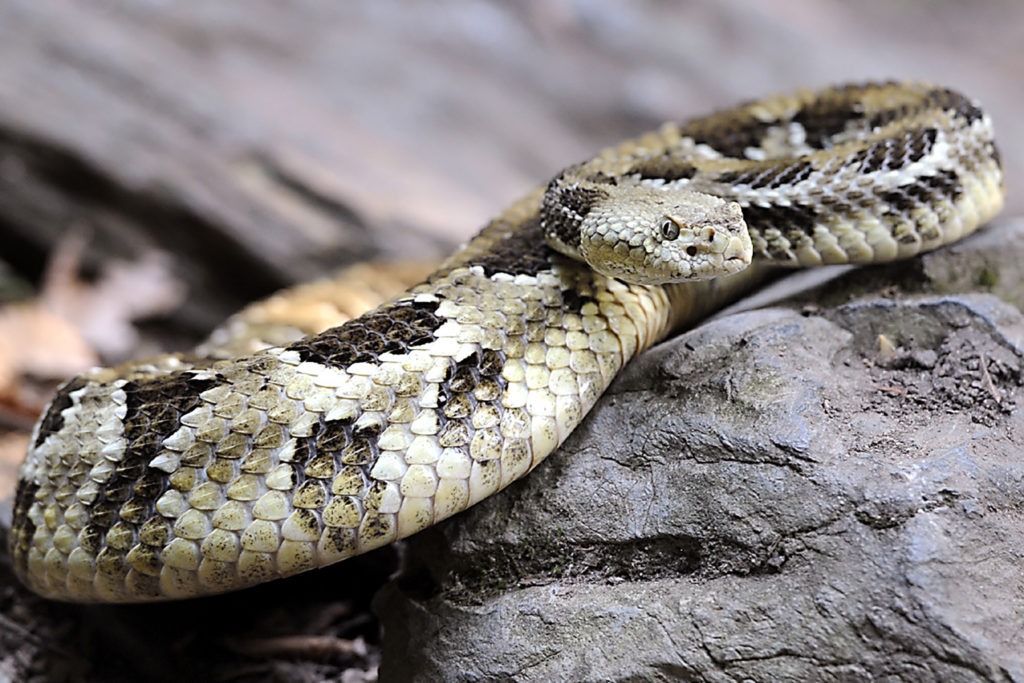Overview
“Where I live”
Timber rattlesnakes are native to the eastern United States and are found in thick brush and dense woodlands. In the northern parts of their range, they live mostly in rocky, hilly, forested terrain. In the southern parts of their range, they are found in swampy areas. Timber rattlesnakes are one of two venomous snakes native to Maryland, and may still exist in very small numbers in the far western part of the state.
You can see timber rattlesnakes on exhibit in the Cave at the Maryland Zoo.
“How I live there”
During the warmer months of the year, timber rattlesnakes are lone predators that sometimes wander many miles from their winter dens in search of prey. They do not tolerate cold well, so they brumate communally in winter dens up to 7 months of the year. Brumation is very similar to hibernation but involved different metabolic processes and allows the animal to be mostly asleep but still capable of occasional activity, such as waking up to drink water.
As pit vipers, timber rattlesnakes have heat-sensitive pits between each eye and nostril that can detect body heat. This makes them capable of locating warm-blooded prey in total darkness. They also are able like other snakes to “taste” the air, taking in chemical information from the environment by flicking their forked tongues and processing it through their special Jacobson’s organs. This chemical processing ability lets snakes follow the scent trail of prey. Timber rattlesnakes are venomous snakes that kill prey by injecting venom deep into their bodies through hollow upper teeth, or fangs.
Timber rattlesnakes feed mainly on small mammals, including mice, rats, squirrels, and rabbits.
One of the most unique features of any rattlesnake is, of course, its rattle. Contrary to popular belief, a rattlesnake does not add a new rattle each year of its life. Instead, every time it sheds its skin, it adds a new ring to the rattle. The faster the snake grows, the more rattles it accumulates, and this is why bigger rattlesnakes have more rings on their rattles. The rattle is used to warn any potentially threatening animal that wanders too close.
“Making my Mark”
Timber rattlesnakes play an important ecological role in their environment, as do all snakes. They help maintain the balance of nature by being both predator and prey. This particular species of snake helps to control rodent populations in its environment.
As venomous snakes, timber rattlesnakes are also potential contributors to human medicine. Scientists are finding that venom is a virtual treasure trove of medically significant chemical compounds. The milky liquid composed of enzymes, proteins, and toxins that act on the body in a variety of ways. Some of venom’s more common effects include blocking the transmission of nerve impulses, thinning blood, shocking the heart, and rapidly breaking down flesh and muscle. Scientists see treatment possibilities in each of these effects. Thinning blood, for example, can help reduce high blood pressure. Blocking nerve impulses that trigger pain can help reduce pain. Already medical researchers have derived some drugs from venom that reduce pain or treat heart disease. They also are investigating compounds in venom that might lead to treatments for nerve diseases such as epilepsy, multiple sclerosis, and Parkinson’s disease; infectious diseases such as tetanus, hepatitis, and malaria; and vision disorders such as cataracts.
“What eats me”
Timber rattlesnakes are shy animals that will not strike unless provoked or frightened. Odds are very much against you ever being bitten by a timber rattlesnake because they are rare and because they are not looking to bite you unless forced. Most snakebites result from people actively trying to handle or kill a snake, so the best way to stay safe in the company of a venomous snake is to leave it alone!
Like other species of rattlesnake, timber rattlesnakes announce their presence when threatened by rattling their tails. This serves as fair warning to any would-be predator that the snake may strike in defense. It may also serve to warn unsuspecting animals that the snake is nearby, as if to say “don’t step on me!”
Raising Young
Mating season for timber rattlesnakes is in the warmer months, from about mid-summer through October. Males follow scent trails to find reproductively active females. Once a male finds a potential mate, he rubs her neck with his chin to initiate mating. Timber rattlesnakes are ovoviviparous, meaning that eggs are fertilized and incubated inside the female, and she gives birth to live young. Female timber rattlesnakes store sperm through the winter months, for use in the spring when they emerge from brumation and ovulate. They give birth to their young usually in late summer and early fall. Mothers shelter and protect their young for about the first week of life.
Conservation
While once widespread throughout their range, timber rattlesnakes have vanished from many areas and remaining populations are patchy. The timber rattlesnake is listed as an endangered species in Maryland. It is illegal to possess or harm a timber rattlesnake in this state.
Taxonomy
- Kingdom: Animalia
- Phylum: Chordata
- Subphylum: Vertebrata
- Class: Reptilia
- Order: Squamata
- Family: Viperidae
- Genera: Crotalus
- Species: horridus


